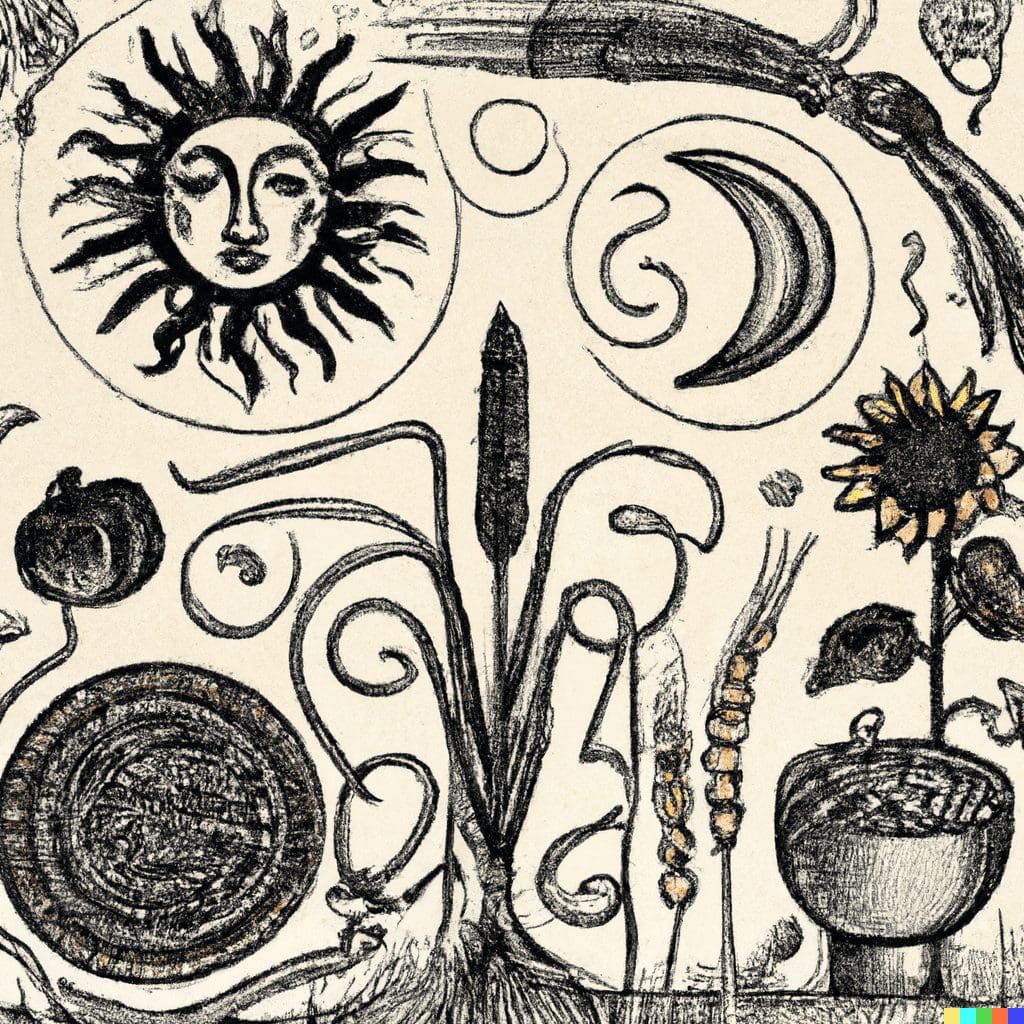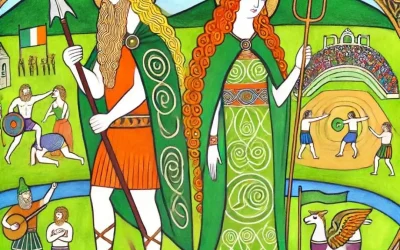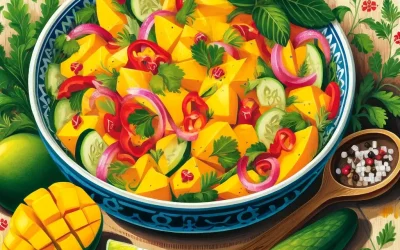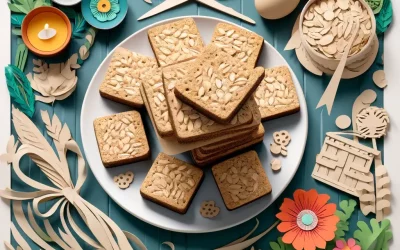LEARN | PAGAN HOLIDAYS | Lughnasadh
EVERYTHING YOU NEED TO KNOW ABOUT LUGHNASADH
Lughnasadh (“LOO-nuh-sah” or “LOO-nah-sahd.” The pronunciation can vary slightly based on regional accents): Celebrating the First Harvest
Updated: April 26, 2024

Lughnasadh 2024
When is Lughnasadh?
In 2024, Lughnasadh is celebrated on August 1st. However, the timing can vary slightly depending on local customs and the specific traditions of various pagan and Wiccan communities. Some practitioners may choose to observe Lughnasadh on July 31st, particularly when aligning the celebration with the eve of the first of August for evening rituals and gatherings. Additionally, others might mark the festival according to the astronomical midpoint between the summer solstice and the autumn equinox, which can slightly adjust the date. In contemporary practice, especially within diverse pagan communities, Lughnasadh festivities may extend over several days to accommodate different geographical and personal schedules, ensuring that all who wish to can partake in the celebrations.
Astrological Insights – Lughnasadh
On the eve of Lughnasadh, July 31, 2024, the Moon enters the nurturing sign of Cancer at 11:19 PM, ushering in a period of instinctual protection and care. This transit heightens concern for the well-being of family, friends, and home, making it a potent time for emotional connections. Intuition and sensitivity are especially pronounced, allowing for a deeper understanding of the energies around you. It’s an ideal time for introspection and connecting with your inner spirit.
The Moon is in its waning crescent phase, signifying a period of release and letting go of what no longer serves you. This phase encourages tapping into your personal magic to realign with your aspirations and desires.
The Significance of Lughnasadh
Lughnasadh is more than just a celebration marking the start of the harvest season; it is a profound acknowledgment of the cycle of growth and sacrifice. Situated between the summer solstice and the autumn equinox, Lughnasadh symbolizes the first fruits of planting labor, reflecting the delicate balance between nature’s bounty and the hard work required to cultivate it. By honoring Lughnasadh, we reconnect with our ancestors’ traditions and the enduring rhythms of the earth.
What is the Origin of Lughnasadh?
Lughnasadh, which rolls around every August 1st with all the subtlety of a tractor in a library, is not just your average seasonal shindig. It originates from ancient Celtic traditions, deeply rooted in the rich soil of Gaelic folklore. Named after the god Lugh, a master of skills and crafts, this festival combines the serious business of a first harvest celebration with the raucous joy of games and feasts. It honors Lugh and commemorates his foster-mother Tailtiu, who, legend has it, died of exhaustion after prepping Ireland for planting. It’s an old-school tribute to the earth’s bounty and those who toil to cultivate it, blending merriment with a dash of somber remembrance.
Lammas vs. Lughnasadh: What’s the Difference?
So, you’ve heard of Lammas and Lughnasadh and are probably thinking, “Aren’t they just two different names for the same summery slice of bread and harvest vibes?” Well, not exactly. While both Lammas and Lughnasadh fall on or around August 1st and celebrate the beginning of the harvest season, they originate from different cultural traditions and hold unique significance within those contexts. Let’s dive into the distinct flavors that each festival brings to the table.
What Makes Lammas Unique
Lammas, often referred to as “Loaf Mass,” is rooted in Christian tradition, emerging from the Anglo-Saxon era in England. The name itself derives from the Old English words “hlaf,” meaning loaf, and “mas,” meaning mass. It is a festival that was traditionally marked by baking bread from the first grain harvest and bringing these loaves to the church to be blessed. This practice highlights Lammas as a Christian celebration, focusing on gratitude for the bounty of the harvest and the sharing of this bounty through the symbol of bread.
Lammas is historically observed by various Christian communities, and the rituals involve not only the breaking and blessing of bread but also prayers for a fruitful harvest season. This makes Lammas predominantly a religious festival with a clear link to Christian worship and community gathering.
What Makes Lughnasadh/Lughnasadh Unique
Lughnasadh, also spelled Lughnasa and pronounced “LOO-nah-sah,” is a Gaelic festival originating from Ireland. Unlike Lammas, Lughnasadh is deeply intertwined with ancient Celtic mythology and cultural practices. It is named after the Celtic god Lugh, known for his skills and crafts. According to lore, the festival commemorates the funeral games Lugh hosted for his foster mother Tailtiu, who died of exhaustion after clearing the lands of Ireland for agriculture.
Lughnasadh is traditionally a time for community gatherings that included athletic contests, storytelling, matchmaking, and ritual ceremonies. It was not just about the agricultural harvest but also about celebrating skills and craftsmanship, reflecting the attributes of the god Lugh himself. The focus on community and the mythological roots of the festival give Lughnasadh a distinct cultural and spiritual flavor, celebrating more than just the harvest—it’s about the endurance and spirit of the community.
Deities of Lughnasadh
Brace yourselves, because Lughnasadh is not just another pretty face in the pagan festival lineup—it’s also a roll call for some of the most fascinating divine figures in Celtic mythology. This festival is steeped in ancient lore, featuring deities who play key roles in agriculture, skill, and sacrifice narratives. Each god and goddess associated with Lughnasadh highlights different aspects of life and spirituality, mirroring the richness of the season and the community’s hopes for abundance and renewal.
Lugh: Celtic God of Light and Craftsmanship
Lugh, known as the master of all arts, is the namesake of Lughnasadh. A deity of light and skill, he is celebrated as a god of craftsmanship, harvest, and warfare. Lugh’s connection to the festival stems from the funeral games he hosted in honor of his foster mother, Tailtiu, who sacrificed herself to clear the lands of Ireland for agriculture. His story encapsulates themes of dedication, protection, and harvest bounty.
Tailtiu: Celtic Goddess of Earth, Fertility and Sacrifice
Tailtiu, the Earth goddess and foster mother of Lugh, is central to the spirit of Lughnasadh. She represents the earth’s fertility and the sacrifices made to nurture the crops. After her death, due to her immense labor in clearing the Irish forests for planting, Lugh inaugurated the festival in her memory. Tailtiu’s legacy is celebrated through the themes of endurance, sacrifice, and nurturing care, which are integral to the harvest season.
Is Lughnasadh Still Celebrated Today?
Yes, Lughnasadh is still actively celebrated today and remains a key event in the calendar of modern pagan and Wiccan communities. As one of the four major Celtic fire festivals and a significant Sabbat in the Wiccan Wheel of the Year, it continues to be a vital part of spiritual and cultural observances. The festival, held on August 1st, marks the beginning of the harvest season. Modern celebrants honor the day with a variety of rituals and activities that blend ancient traditions with contemporary practices—these include lighting bonfires, baking bread, crafting, and engaging in ceremonies that celebrate the season’s bounty. This continuation and adaptation of Lughnasadh practices ensure that its ancient significance is preserved while being relevant in today’s world.
The Colors, Crystals, Scents, Herbs, Plants, Flowers, and Symbols of Lughnasadh
As the wheel of the year turns to Lughnasadh, we are reminded of the abundant harvest and the warm, radiant energy of the sun. To fully embrace and celebrate this season, consider incorporating the following colors, herbs, plants, crystals, scents, and symbols that resonate with the spirit of Lughnasadh. Each element carries its unique meaning, helping to infuse your celebrations with the essence of this ancient pagan festival. From vibrant colors symbolizing the sun’s warmth and the earth’s fertility to potent herbs, plants, and flowers representing protection and growth, let these elements inspire and enhance your Lughnasadh rituals and festivities.
Colors
- Yellow: Represents the sun, warmth, and abundance of the harvest
- Orange: Symbolizes the ripening of fruits and the vibrant energy of the season
- Red: Stands for the life force and vitality that sustain us
- Brown: Represents the earth and the grounding energy of the harvest
- Green: Symbolizes the fertility of the land and the growth of plants and crops
Crystals
- Citrine: Represents abundance, prosperity, and the energy of the sun
- Aventurine: Symbolizes growth, abundance, and the manifestation of one’s desires
- Tiger’s Eye: Encourages strength, protection, and clarity during the harvest season
- Carnelian: Energizes and promotes motivation, courage, and confidence
Scents
- Sandalwood: Used for purification and protection, as well as to honor the sun
- Frankincense: Represents abundance, spirituality, and connection to the divine
- Cinnamon: Symbolizes warmth, abundance, and the transformative energy of the season
Symbols
- Sheaves of wheat, corn, or barley: Represent the first harvest and the sustenance provided by the earth
- Corn dollies or cornucopia: Symbolize abundance and the blessings of the harvest
- Sickle or scythe: Tools traditionally used for reaping the harvest, representing the cyclical nature of life and death
- Bread and grains: Embody the transformation of the harvest into nourishment and sustenance
Herbs, Plants, and Flowers
- Wheat, barley, and corn: The main crops associated with the harvest
- Meadowsweet: A fragrant herb traditionally used for love and protection spells
- Heather: Represents good luck and protection, often used in rituals and ceremonies
- Hollyhock: Symbolizes fertility and abundance
- Sunflower: Represents the sun’s energy and the joy of the season
Traditional Lughnasadh Foods
Lughnasadh is a feast for the senses, and what’s a feast without food? Here are some traditional favorites:
- Freshly Baked Bread: Represents the first grain harvest, transformed through the alchemy of baking.
- Berries: Summer berries are often ripe and abundant around Lughnasadh.
- Roasted Corn: Freshly harvested corn, roasted and buttered, is a savory tribute to the sun and the season.
- Barley Soups or Stews: Utilizing the grain of the season, these hearty dishes nourish body and soul alike.
- Lamb or Mutton: In cultures where herding was prevalent, these meats might be a traditional choice.
10 Easy Ways to Celebrate Lughnasadh
Bake Bread
There’s nothing quite like the aroma of fresh bread to signify the harvest.
Visit a Farmers Market
Support local farmers and enjoy the first fruits of the harvest.
Make Corn Dollies
Craft these traditional figures as a creative way to celebrate the season.
Hold a Harvest Supper
Invite loved ones to feast and give thanks for the bounty of the season.
Walk in Nature
Observe the ripe fields, the high sun, the signs of summer at its peak.
Preserve Fruit
Make jams or jellies from summer berries to enjoy throughout the year.
Donate to a Food Bank
Share the abundance of the season with others in need.
Journal on Abundance
Reflect on the areas of your life that feel abundant and those where you’d like to invite more abundance.
Create a Lughnasadh Altar
Use corn, wheat, sunflowers, or other symbols of the harvest.
Meditate on the Cycle of Life
Contemplate the cycle of growth, harvest, death, and rebirth, and how it plays out in your own life.
Learn About Sabbats
You’ve just stumbled upon your new favorite travel guide through the cosmic calendar, the Wheel of the Year.
Imbolc
February
Ostara
March - Spring Equinox
Beltane
May
Litha
June - Summer Solstice
Lughnasadh
August
Mabon
September - Autumn Equinox
Samhain
October
Yule
December - Winter Solstice



